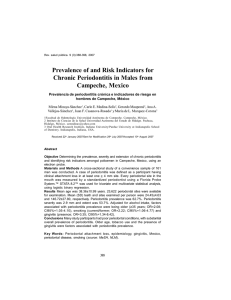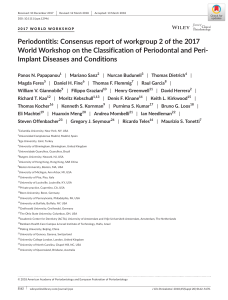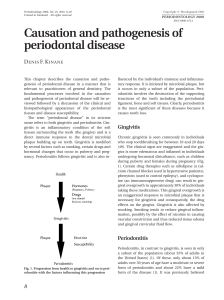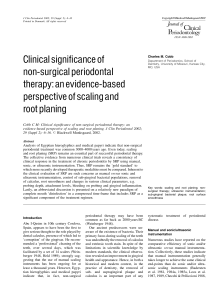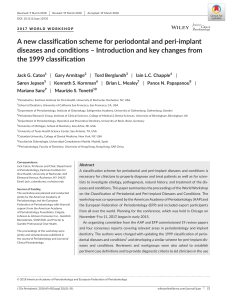Comparison of independent and dependent culture methods for the
Anuncio
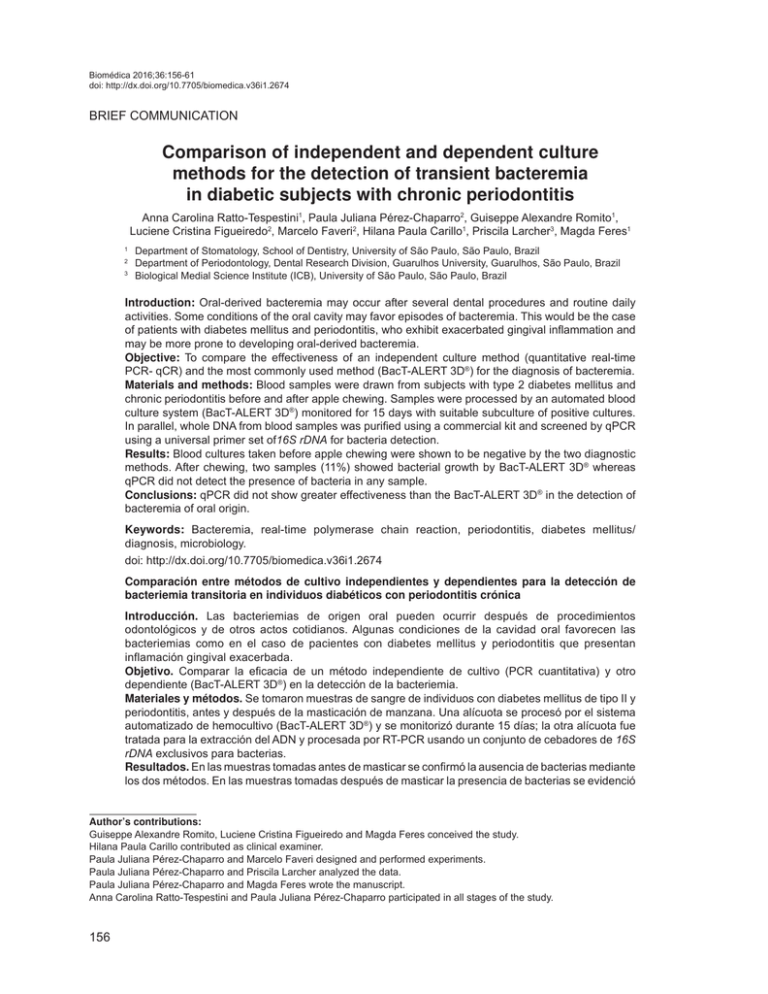
Ratto-Tespestini Biomédica 2016;36:156-61 AC, Pérez-Chaparro PJ, Romito GA, et al. doi: http://dx.doi.org/10.7705/biomedica.v36i1.2674 Biomédica 2016;36:156-61 BRIEF COMMUNICATION Comparison of independent and dependent culture methods for the detection of transient bacteremia in diabetic subjects with chronic periodontitis Anna Carolina Ratto-Tespestini1, Paula Juliana Pérez-Chaparro2, Guiseppe Alexandre Romito1, Luciene Cristina Figueiredo2, Marcelo Faveri2, Hilana Paula Carillo1, Priscila Larcher3, Magda Feres1 1 2 3 Department of Stomatology, School of Dentistry, University of São Paulo, São Paulo, Brazil Department of Periodontology, Dental Research Division, Guarulhos University, Guarulhos, São Paulo, Brazil Biological Medial Science Institute (ICB), University of São Paulo, São Paulo, Brazil Introduction: Oral-derived bacteremia may occur after several dental procedures and routine daily activities. Some conditions of the oral cavity may favor episodes of bacteremia. This would be the case of patients with diabetes mellitus and periodontitis, who exhibit exacerbated gingival inflammation and may be more prone to developing oral-derived bacteremia. Objective: To compare the effectiveness of an independent culture method (quantitative real-time PCR- qCR) and the most commonly used method (BacT-ALERT 3D®) for the diagnosis of bacteremia. Materials and methods: Blood samples were drawn from subjects with type 2 diabetes mellitus and chronic periodontitis before and after apple chewing. Samples were processed by an automated blood culture system (BacT-ALERT 3D®) monitored for 15 days with suitable subculture of positive cultures. In parallel, whole DNA from blood samples was purified using a commercial kit and screened by qPCR using a universal primer set of16S rDNA for bacteria detection. Results: Blood cultures taken before apple chewing were shown to be negative by the two diagnostic methods. After chewing, two samples (11%) showed bacterial growth by BacT-ALERT 3D® whereas qPCR did not detect the presence of bacteria in any sample. Conclusions: qPCR did not show greater effectiveness than the BacT-ALERT 3D® in the detection of bacteremia of oral origin. Keywords: Bacteremia, real-time polymerase chain reaction, periodontitis, diabetes mellitus/ diagnosis, microbiology. doi: http://dx.doi.org/10.7705/biomedica.v36i1.2674 Comparación entre métodos de cultivo independientes y dependientes para la detección de bacteriemia transitoria en individuos diabéticos con periodontitis crónica Introducción. Las bacteriemias de origen oral pueden ocurrir después de procedimientos odontológicos y de otros actos cotidianos. Algunas condiciones de la cavidad oral favorecen las bacteriemias como en el caso de pacientes con diabetes mellitus y periodontitis que presentan inflamación gingival exacerbada. Objetivo. Comparar la eficacia de un método independiente de cultivo (PCR cuantitativa) y otro dependiente (BacT-ALERT 3D®) en la detección de la bacteriemia. Materiales y métodos. Se tomaron muestras de sangre de individuos con diabetes mellitus de tipo II y periodontitis, antes y después de la masticación de manzana. Una alícuota se procesó por el sistema automatizado de hemocultivo (BacT-ALERT 3D®) y se monitorizó durante 15 días; la otra alícuota fue tratada para la extracción del ADN y procesada por RT-PCR usando un conjunto de cebadores de 16S rDNA exclusivos para bacterias. Resultados. En las muestras tomadas antes de masticar se confirmó la ausencia de bacterias mediante los dos métodos. En las muestras tomadas después de masticar la presencia de bacterias se evidenció Author’s contributions: Guiseppe Alexandre Romito, Luciene Cristina Figueiredo and Magda Feres conceived the study. Hilana Paula Carillo contributed as clinical examiner. Paula Juliana Pérez-Chaparro and Marcelo Faveri designed and performed experiments. Paula Juliana Pérez-Chaparro and Priscila Larcher analyzed the data. Paula Juliana Pérez-Chaparro and Magda Feres wrote the manuscript. Anna Carolina Ratto-Tespestini and Paula Juliana Pérez-Chaparro participated in all stages of the study. 156 Biomédica 2016;36:156-61 PCR versus culture for bacteremia detection únicamente en dos hemocultivos y en ninguna de las muestras se detectó la presencia de bacterias con el método de RT-PCR. Conclusiones. La PCR cuantitativa no mostró mayor eficacia que el BacT-ALERT 3D® en la detección de la bacteriemia de origen oral. Palabras clave: bacteriemia, reacción en cadena de la polimerasa en tiempo real, periodontitis, diabetes mellitus/diagnóstico, microbiología. doi: http://dx.doi.org/10.7705/biomedica.v36i1.2674 Bacteria may be transiently found in the bloodstream after dental healthcare procedures such as scaling and root planning (1-6),as well as during certain daily activities involving the gums, such as mastication or tooth brushing (5,7). However, these bacteria are normally eliminated by the host immune system after a short period of time (5,7,8). This event, known as transient bacteremia of oral origin, might lead to endocarditis (9) or favor other chronic processes, such as atherosclerosis (8,10,11). Periodontitis is a polymicrobial infection caused by microorganisms that colonize and may invade periodontal tissues, leading to connective tissue and alveolar bone loss. Oral biofilm accumulation and the concomitant inflammatory response associated with periodontitis have been shown to be closely related to transient oral-derived bacteremia (12-14). The ulcerated pocket epithelium underlying the highly vascularized and dilated vascular network of the adjacent connective tissue contribute to the migration of microorganisms into the bloodstream (9). In addition, this process may be favored by intermittent changes in vessel pressure after any intervention surrounding the gum, because the blood pressure becomes negative, making it possible for bacteria to spill into the blood stream (15). Therefore, the risk of presenting transient bacteremia depends not only on bacterial load, but also on the severity of gingival inflammation. From this perspective, patients with inflammatory response disorders may be more prone to developing transient bacteremia. This might be the case of patients diagnosed with diabetes mellitus (DM), who exhibit worse gingival inflammation when they suffer from periodontal disease (16-19). Therefore, these patients may be at an increased risk for developing transient bacteremia. Corresponding author: Magda Feres, Centro de Pós-Graduação e Pesquisa-CEPPE, Universidade Guarulhos, Praça Tereza Cristina, 229 Centro, 07023-070 Guarulhos, SP, Brazil Telephone: (5511) 2087 3594, fax: (5511) 2087 3594 mferes@ung.br Recibido: 31/01/15; aceptado: 29/07/15 To date several methods, including dependent and independent culture techniques, have been used to detect bacteria in blood during oralderived transient bacteremia (1,20-22). The most commonly used methods are the continuousmonitoring blood culture systems (23), such as the BacT-ALERT 3D®. However, these systems have several disadvantages, such as high cost, being time consuming, requiring a continuous power supply, frequent technical maintenance, the occurrence of false positive results due to contamination and having low sensitivity for the detection of some fastidious bacteria (23-25). On the other hand, molecular diagnostic techniques, such as polymerase chain reaction (PCR) may be more affordable and more sensitive than bacterial culture techniques, and may detect the fastidious microorganisms normally associated with the etiology of periodontitis. However, to date no studies have compared cultural and molecular techniques as regards their effectiveness in detecting the occurrence of bacteremia during chewing in patients with chronic periodontitis. Therefore, the aim of this study was to compare the effectiveness of an independent culture method (quantitative PCR- qPCR) and the method routinely used in clinical laboratory (BacT-ALERT 3D®) for diagnosing bacteremia in these patients. Materials and methods Study population Eighteen subjects with type 2 DM with glycated hemoglobin (HbA1c) levels ≥7.0% and ≤10%, (ADA, 2012) diagnosed with chronic periodontitis (ChP) (>40 years old; with at least 15 teeth excluding third molars and teeth with advanced decay indicated for extraction); a minimum of six teeth with at least one site with probing depth (PD) and clinical attachment level (CAL) ≥5 mm and bleeding on probing at baseline, and at least 30% of the sites with concomitant PD and CAL ≥4 mm were selected from the Dental Clinic of São Paulo University (FOUSP). All the participants signed a term of free and informed consent, which was 157 Ratto-Tespestini AC, Pérez-Chaparro PJ, Romito GA, et al. approved by the Research Ethics Committee of FOUSP (#173 / 2010). A single trained examiner performed all clinical examinations. Induced bacteremia and blood sampling Bacteremia was induced by chewing a Fiji apple. The subjects were instructed to take three bites of the apple, chew and ingest them in about 2 minutes (22). They were also asked to avoid oral hygiene, and not to eat and drink (except water) for at least 8 hours before the dental appointment. The blood samples were collected by venipuncture. In order to prevent external contamination, sample collection was performed in accordance with the Standard Operational Procedure of the Clinical Laboratory Service of São Paulo University’s Hospital, which included the use of gloves, disinfection of the vial stopper with 70% alcohol, skin antisepsis with 70% alcohol and 10% providone iodine, and the use of sterile sets. Peripheral venous blood (10 mL) was drawn at baseline (T0) and 2 min ± 30 s after the first apple bite (T1) (22). An aliquot of the blood sample (T0) was inoculated in 6 mL K2 EDTA Vacutainer®tubes (BD Vacutainer®, Curitiba, PR, Brazil) and the second sample (T1) was stored at -80°C until processed for DNA extraction and suitable qPCR reaction. Sample processing Five milliliters of blood sample were inoculated in parallel in culture bottles for aerobic (Bact/Alert 3D FA- Biomeriéux) and anaerobic microorganisms (Bact /Alert 3D FN- BioMeriéux) and monitored for 15 days. In case of positive bacterial growth detection by the BacT-ALERT® (BioMérieux) system, a Gram stain of the culture was performed. Positives blood cultures were sub-cultured on blood and chocolate agar and incubated under anaerobic conditions. Sub-cultures were also performed on MacConkey agar and incubated under aerobic conditions. Bacteria were identified by the automated microbiology identification system VITEK®2 compact (BioMérieux, Inc. Hazelwood, MO). Total DNA extraction from blood samples was performed using the MasterPureTM complete DNA and RNA purification kit (Epicentre, Madison, WI, USA). Samples were processed for 16S rDNA detection by qPCR. The following primer set was used: 16SrDNA F:5’gtgStgcaYggYtgtcgtca 3’ and 16SrDNA R:5’acgtcRtccMcaccttcctc 3’ (26). The reaction mixture was made in accordance with the Cylcer® FastStart DNA Master PLUS SYBR Green I (Roche, Cat. No 03515 885001) 158 Biomédica 2016;36:156-61 manufacturer’s instructions by adding 2.5 μl of DNA template (20 ng/μL). Reactions were performed on a LightCycler 2.0 (Roche Diagnostics GmbH, Mannheim, Germany). The following PCR conditions were used: 94°C for 10 min, followed by 40 cycles of 95°C for 10 s; 56°C for 5 s; and 72°C for 7s. After amplification, the melting curve was made from 65 to 95°C with a plate read out at every 0.1°C. Calibration standard curves were prepared with serial dilutions (107 to 102) of DNA from a mock community of oral microorganisms with an equal number of genomes per species. The genome copies per reaction were calculated taking into account the individual genome size and the mean weight of one nucleotide pair (27). DNA from a mock community of oral microorganisms consisted of a mixture of genomic DNA from five species (Porphyromonas gingivalis, Tannerella forsythia, Treponema denticola, Actinomyces odontyculus, Streptococcus oralis and Fusobacterium nucleatum). Afterwards, the CT value of each sample was plotted against the standard curve in order to determine the amount of target cells. The level of detection was set to (log2) 102 bacteria. Results The patients’ demographics and mean periodontal clinical parameters are presented in table 1. Thirteen men and five women participated in the study. The mean age of the population was 55.45±10.14. The mean PD (3.59±1.4) and CAL (4.1±1.5) of the population included in this study characterize advanced periodontitis. Table 2 summarizes the microbiological data. No sample was positive for bacterial detection at T0, either by BacT-ALERT® test, or by qPCR. After apple chewing (T2), two samples out of the 18 subjects evaluated (11%) were positive for transient bacteremia by the BacT-ALERT® test. One blood Table 1. Demographic characteristics and mean (±SD) fullmouth clinical parameters of the subjects included in the study Variable Age (years) Gender (M/F) Weight (kg) Height (m) Body Mass Index Probing depth (mm) Clinical attachment level (mm) Percentage of sites with: Gingival bleeding Bleeding on probing Base line 55.45±10.14 13/5 85.5±15.10 1.6 8±0.08 17.9 3.59 (±1.4) 4.1 (±1.5) 52 % 59.5 % Biomédica 2016;36:156-61 Table 2. Results of bacterial detection in blood samples evaluated by BacT-ALERT® and qPCR, before and after apple chewing Time point (number of samples) Number of samples positive by BacTALERT® Number of samples positive by qPCR T0 (n=18) 0 0 T1 (n=18) 2* 0 * Staphylococcus epidermidis and a Gram-positive facultative anaerobic rod-shaped bacterium identified by system VITEK2® compact culture was positive for Staphylococcus epidermidis and the other was positive for a Gram-positive, facultative anaerobic, rod-shaped bacterium. As regards the analysis by qPCR, the standardization step indicated the set of primers was target specific, as shown by the melting curve analysis, and the DNA recovered from the samples was suitable for evaluation by PCR. Nevertheless, none of the screened samples was positive for bacterial detection by qPCR. Discussion We were able to detect oral-induced bacteremia after apple chewing by the BacT-ALERT® system in 2/18 (11%) subjects with type 2 DM suffering from ChP; however, bacterial detection by qPCR failed. The lack of bacterial detection by qPCR, even in the samples that were positive in the hemoculture, may be due to the fact that there was an increased amount of host DNA, yielding an unbalanced microorganisms-to-host DNA ratio. This imbalance might have prevented the primer set from hybridizing with the target bacterial DNA, hampering the performance of PCR. This fact has been pointed out in other manuscripts dealing with samples in which human DNA was more concentrated in comparison with microbial DNA, e.g. blood, saliva and subgingival biofilm samples (28-30). In order to minimize this problem, some approaches could be used before performing PCR, such as depletion of human DNA or selection of prokaryotic DNA during extraction protocols (28-32). One of the bacterial species identified in one individual blood sample was S. epidermidis, which has previously been isolated from blood cultures after tooth extraction (33). In addition, S. epidermidis has been detected in subgingival samples of patients with periodontitis by Murdoch, et al. (34), who found this species in 64.3% of subjects with ChP. Furthermore, Loberto, et al. (35), isolated Staphylococcus spp. from the subgingival PCR versus culture for bacteremia detection samples of 37.5% of subjects with periodontitis, and S. epidermidis was the most frequently detected species. Similar results have previously been reported by Rams, et al. (36), who detected Staphylococcus spp. in the subgingival samples of 18.5% of adults with ChP, and 45.8% of the species detected were S. epidermidis. One might ask whether the coagulase negative Staphylococcus could be a contaminant (false-positive result) found in blood cultures. This contaminant is related to the commensal microbiota of the patient’s skin, and is therefore associated with inadequate skin preparation during blood collection (37-39). However, this is probably not the case in the present study, since S. epidermidis was identified at a rate of 0.18% in all the hemocultures (n=18) and providone iodine was used as antiseptic for skin decontamination (37). The second positive blood sample in this study harbored Grampositive facultative anaerobic rod-shaped isolates, characteristic of some subgingival periodontal microorganisms, such as the Actinomyces species. In this study, oral transient bacteremia induced after apple chewing was shown to be positive by the BacT-ALERT® system in 2/18 (11%) subjects with type 2 DM suffering from ChP. The frequency of bacteremia after apple chewing in the present study was 11%, a frequency higher than that previously reported in non-diabetic individuals (33). Maharaj, et al. (33), failed to detect bacteremia after apple chewing using the BacT-ALERT® system in 60 systemically healthy subjects with periodontal disease. The same situation was reported by Murphy, et al. (40), in 21 subjects with ChP after chewing paraffin wax for four minutes. The higher prevalence of bacteremia found in the present study compared with the findings of Maharaj, et al.(33), and Murphy, et al. (36), could be explained by the exacerbated inflammation process of the periodontal tissues in diabetic patients, and possibly by their impaired host immune system, which hampered bacterial clearance from the blood (41). On the other hand, Forner, et al. (42), reported that four out of 20 (20%) systemically healthy patients with ChP were positive for bacteremia after chewing; however, in the cited study, the authors used chewing gum for a period of 10 min. In summary, the data of the present study suggested that qPCR does not show greater sensitivity than the BacT-ALERT 3D® system in the diagnosis of transitory bacteremia of oral origin in subjects with type 2 DM suffering from ChP. 159 Ratto-Tespestini AC, Pérez-Chaparro PJ, Romito GA, et al. Conflicts of interest The authors declare absence of any conflict of interest. Financial support Biomédica 2016;36:156-61 12.Heimdahl A, Hall G, Hedberg M, Sandberg H, Söder PO, Tunér K, et al. Detection and quantitation by lysis-filtration of bacteremia after different oral surgical procedures. J Clin Microbiol. 1990;28:2205-9. http://dx.doi.org/0095-1137/ 90/102205-0502.00/0 References 13.Okabe K, Nakagawa K, Yamamoto E. Factors affecting the occurrence of bacteremia associated with tooth extraction. Int J Oral Maxillofac Surg. 1995;24:239-42. http://dx.doi. org/10.1016/S0901-5027(06)80137-2 1. Lafaurie GI, Mayorga-Fayad I, Torres MF, Castillo DM, Aya MR, Barón A, et al. Periodontopathic microorganisms in peripheric blood after scaling and root planing. J Clin Periodontol. 2007;34:873-92. http://dx.doi.org/10.1111/j. 1600-051X.2007.01125.x 14.Rajasuo A, Perkki K, Nyfors S, Jousimies-Somer H, Meurman JH. Bacteremia following surgical dental extraction with an emphasis on anaerobic strains. J Dent Res. 2004;83:170-4. http://dx.doi.org/10.1177/ 154405910408300217 2. Lockhart PB, Brennan MT, Sasser HC, Fox PC, Paster BJ, Bahrani-Mougeot FK. Bacteremia associated with tooth brushing and dental extraction. Circulation. 2008;117:311825. http://dx.doi.org/10.1161/CIRCULATIONAHA.107.758524 15.Roberts GJ. Dentists are innocent! “Everyday” bacteremia is the real culprit: A review and assessment of the evidence that dental surgical procedures are a principal cause of bacterial endocarditis in children. Pediatr Cardiol. 1999;20:317-25. http://dx.doi.org/10.1007/s002469900477 FAPESP grant 2012/20915-0 3. Pérez-Chaparro PJ, Gracieux P, Lafaurie GI, Donnio P-Y, Bonnaure-Mallet M. Genotypic characterization of Porphyromonas gingivalis isolated from subgingival plaque and blood sample in positive bacteremia subjects with periodontitis. J Clin Periodontol. 2008;35:748-53. http://dx. doi.org/10.1111/j.1600-051X.2008.01296.x 4. Parahitiyawa NB, Jin LJ, Leung WK, Yam WC, Samaranayake LP. Microbiology of odontogenic bacteremia: Beyond endocarditis. Clin Microbiol Rev. 2009;22:46-64. http://dx.doi.org/10.1128/CMR.00028-08 5. Benitez-Páez A, Álvarez M, Belda-Ferre P, Rubido S, Mira A, Tomás I. Detection of transient bacteraemia following dental extractions by 16S rDNA pyrosequencing: A pilot study. PLoS One. 2013;8:e57782. http://dx.plos. org/10.1371/journal.pone.0057782 6. Waghmare AS, Vhanmane PB, Savitha B, Chawla RL, Bagde HS. Bacteremia following scaling and root planing: A clinico-microbiological study. J Indian Soc Periodontol. 2013;17:725-30. http://dx.doi.org/10.4103/0972124X.124480 7. Pérez-Chaparro PJ, Meuric V, De Mello G, BonnaureMallet M. Bactériémies d’origine buccale. Rev Stomatol Chir Maxillofac. 2011;112:300-3. http://dx.doi.org/10.1016/j. stomax.2011.08.012 8. Li X, Kolltveit KM, Tronstad L. Systemic diseases caused by oral infection. Clin Microbiol Rev. 2000;13:547-58. http:// dx.doi.org/10.1128/CMR.13.4.547-558.2000 9. Parahitiyawa NB, Jin LJ, Leung WK, Yam WC, Samaranayake LP. Microbiology of odontogenic bacteremia: Beyond endocarditis. Clin Microbiol Rev. 2009;22:46-64. http:/dx.doi.org/10.1128/CMR.00028-08 10. Brodala N, Merricks EP, Bellinger DA, Damrongsri D, Offenbacher S, Beck J, et al. Porphyromonas gingivalis bacteremia induces coronary and aortic atherosclerosis in normocholesterolemic and hypercholesterolemic pigs. Arterioscler Thromb Vasc Biol. 2005;25:1446-51. http:/ dx.doi.org/10.1161/01.ATV.0000167525.69400.9c 11. Padilla C, Lobos O, Hubert E, Gonzalez C, Matus S, Pereira M, et al. Periodontal pathogens in atheromatous plaques isolated from patients with chronic periodontitis. J Periodontal Res. 2006;41:350-3. http://dx.doi.org/10.1111/ j.1600-0765.2006.00882.x 160 16.Hanes PJ, Krishna R. Characteristics of inflammation common to both diabetes and periodontitis: Are predictive diagnosis and targeted preventive measures possible? EPMA J. 2010;1:101-16. http://dx.doi.org/10.1007/s13167010-0016-3 17.Preshaw PM, Bissett SM. Periodontitis: Oral complication of diabetes. Endocrinol Metab Clin North Am. 2013;42:84967. http://dx.doi.org/10.1016/j.ecl.2013.05.012 18.Chee B, Park B, Bartold PM. Periodontitis and type II diabetes: A two-way relationship. Int J Evid Based Healthc. 2013;11:317-29. http://dx.doi.org/10.1111/1744-1609.12038 19.Chapple IL, Genco R. Diabetes and periodontal diseases: Consensus report of the Joint EFP/AAP Workshop on Periodontitis and Systemic Diseases. J Clin Periodontol. 2013;40:S106-12. http://dx.doi.org/10.1111/jcpe.12077 20.Lucas VS, Lytra V, Hassan T, Tatham H, Wilson M, Roberts GJ. Comparison of lysis filtration and an automated blood culture system (BACTEC) for detection, quantification, and identification of odontogenic bacteremia in children. J Clin Microbiol. 2002;40:3416-20. http://dx.doi.org/10.1128/ JCM.40.9.3416-3420.2002 21.Kinane DF, Riggio MP, Walker KF, MacKenzie D, Shearer B. Bacteraemia following periodontal procedures. J Clin Periodontol. 2005;32:708-13. http://dx.doi.org/10.1111/j. 1600-051X.2005.00741.x 22.Fine DH, Furgang D, McKiernan M, Tereski-Bischio D, Ricci-Nittel D, Zhang P, et al. An investigation of the effect of an essential oil mouth rinse on induced bacteraemia: A pilot study. J Clin Periodontol. 2010.37:840-7. http://dx.doi. org/ 10.1111/j.1600-051X.2010.01599.x 23.Dreyer AW. Sepsis- An ongoing and significant challenge. In Tech; 2012. p. 287-310. Fecha de consulta: 10 de junio de 2014. Disponible en: http://dx.doi.org/10.5772/5039 24.Klaerner H, Eschenbach U, Kamereck K, Lehn N, Miethke T. Failure of an automated blood culture system to detect non fermentative gram-negative bacteria. J Oral Microbiol. 2000;38:1036-41. 25.Seegmuller I. Sensitivity of the BacT/ALERT FA-medium for detection of Pseudomonas aeruginosa in pre-incubated Biomédica 2016;36:156-61 blood cultures and its temperature-dependence. J Med Microbiol. 2004;53:869-74. http://dx.doi.org/10.1099/jmm. 0.45533-0 26.Maeda H, Fujimoto C, Haruki Y, Maeda T, Kokeguchi S, Petelin M, et al. Quantitative real-time PCR using TaqMan and SYBR Green for Actinobacillus actinomycetemcomitans, Porphyromonas gingivalis, Prevotella intermedia, tetQ gene and total bacteria. FEMS Immunol Med Microbiol. 2003;39:81-6. http://dx.doi.org/10.1016/S0928-8244(03) 00224-4 27.Dolezel J, Bartos J, Voglmayr H, Greilhuber J. Nuclear DNA content and genome size of trout and human. Cytometry. 2003;51:127-8. http://dx.doi.org/10.1002/cyto. a.10013 28. Horz HP, Scheer S, Huenger F, Vianna ME, Conrads G. Selective isolation of bacterial DNA from human clinical specimens. J Microbiol Methods. 2008;72:98-102. http:/dx. doi.org/10.1016/j.mimet.2007.10.007 29.Horz HP, Scheer S, Vianna ME, Conrads G. New methods for selective isolation of bacterial DNA from human clinical specimens. Anaerobe. 2010;16:47-53. http://dx.doi.org/10. 1016/j.anaerobe.2009.04.009 30.Oyola SO, Gu Y, Manske M, Otto TD, O’Brien J, Alcock D, et al. Efficient depletion of host DNA contamination in malaria clinical sequencing. J Clin Microbiol. 2013;51:74551. http:/dx.doi.org/10.1128/JCM.02507-12 31.Hunter SJ, Easton S, Booth V, Henderson B, Wade WG, Ward JM. Selective removal of human DNA from metagenomic DNA samples extracted from dental plaque. J Basic Microbial. 2011;51:442-6. http://dx.doi.org/10.1002/ jobm.201000372 32.Horton JR, Mabuchi MY, Cohen-Karni D, Zhang X, Griggs RM, Samaranayake M, et al. Structure and cleavage activity of the tetrameric MspJI DNA modificationdependent restriction endonuclease. Nucleic Acids Res. 2012;40:9763-73. http://dx.doi.org /10.1093/nar/gks719 33. Maharaj B, Coovadia Y, Vayej AC. An investigation of the frequency of bacteraemia following dental extraction, tooth brushing and chewing. Cardiovasc J Afr. 2012;23:340-4. http://dx.doi.org/10.5830/CVJA-2012-016 PCR versus culture for bacteremia detection 34.Murdoch FE, Sammons RL, Chapple IL. Isolation and characterization of subgingival Staphylococci from periodontitis patients and controls. Oral Dis. 2004;10:15562. http://dx.doi.org/10.1046/j.1601-0825.2003.01000.x 35.Loberto JC, Martins CA, Ferreira SS, Cortelli JR, Olavo A. Staphylococcus spp. in the oral cavity and periodontal pockets of chronic periodontitis patients. Braz J Microbiol. 2004;36:64-8. http://dx.doi.org/10.1590/S151783822004000100010 36. Rams T, Feik D, Slots J. Staphylococci in human periodontal diseases. Oral Microbiol Immunol. 1990;5:29-32. 37.Chukwuemeka II, Samuel Y. Quality assurance in blood culture: A retrospective study of blood culture contamination rate in a tertiary hospital in Nigeria. Niger Med J. 2014;55:201-3. http://dx.doi.org/10.4103/0300-1652. 132038 38.Hall KK, Lyman JA. Updated review of blood culture contamination. Clin Microbiol Rev. 2006;19:788-802. http:// dx.doi.org/10.1128/CMR.00062-05 39.Viagappan M, Kelsey MC. The origin of coagulasenegative staphylococci isolated from blood cultures. J Hosp Infect.1995;30:217-23. 40. Murphy AM, Daly CG, Mitchell DH, Stewart D, Curtis BH. Chewing fails to induce oral bacteraemia in patients with periodontal disease. J Clin Periodontol. 2006;33:730-6. http://dx.doi.org/10.1111/j.1600-051X.2006.00980.x 41.Kaasch AJ, Barlow G, Edgeworth JD, Fowler VG, Hellmich M, Hopkins S, et al. Staphylococcus aureus blood stream infection: A pooled analysis of five prospective, observational studies. J Infect. 2014;68:242-51. http://dx. doi.org/10.1016/j.jinf.2013.10.015 42.Forner L, Larsen T, Kilian M, Holmstrup P. Incidence of bacteremia after chewing, tooth brushing and scaling in individuals with periodontal inflammation. J Clin Periodontol. 2006;33:401-7. http://dx.doi.org/10.1111/j.1600051X.2006.00924.x 161


